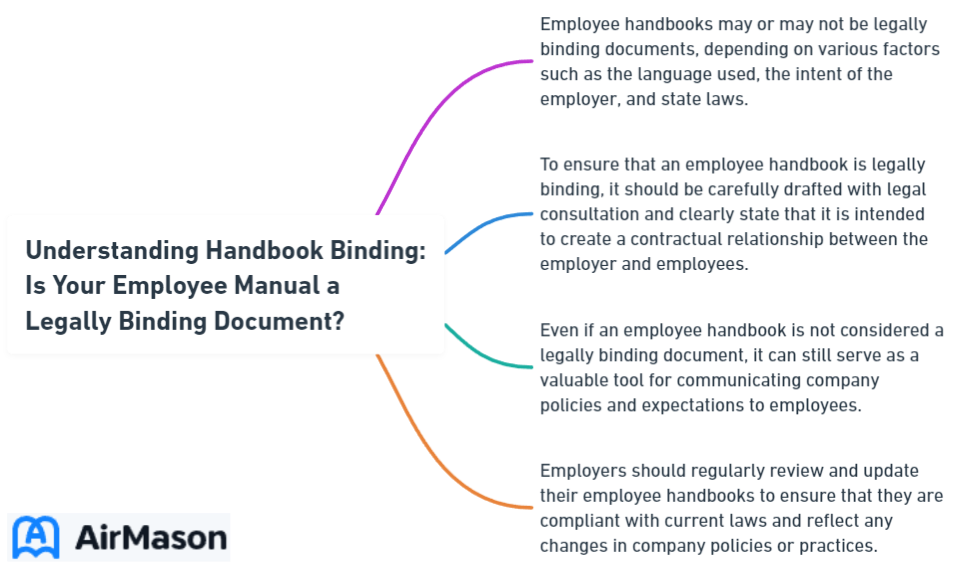
What elevates an employee handbook to the status of a binding contract? Our investigation into handbook binding provides definitive insights into how a set of company policies can turn into enforceable commitments. Here, we’ll dissect the conditions, legal precedents, and language that dictate when handbooks bind—and when they don’t. Expect a blend of legal know-how and practical advice, all geared towards clarifying the binding power of handbooks in the workplace.
Key Takeaways
- An employee handbook can become a legally binding contract if it includes specific contractual elements and if employee acknowledgment of its terms is required, potentially influencing employment disputes.
- Clarity in handbook provisions is essential to minimize legal risks by clearly outlining job duties, company policies, disciplinary actions, and termination procedures, and by using disclaimers to preserve at-will employment status.
- Regular updating and modifying of the employee handbook are necessary to reflect changes in laws and company policies, and to ensure legal compliance and relevance within an organization.
Employee Handbook Introduction
Welcome to our company! This Employee Handbook Introduction serves as a comprehensive guide outlining our organization’s policies, procedures, and expectations. As you embark on your journey with us, it’s essential to familiarize yourself with the contents of this handbook, as it will provide you with valuable information regarding our company culture, values, and guidelines for conduct. Our commitment to fostering a positive and inclusive work environment is reflected in the principles outlined within these pages. From workplace ethics to safety protocols, this handbook serves as a roadmap for navigating your role within our organization. We encourage you to reference it frequently and reach out to HR if you have any questions or concerns.
Deciphering the Binding Nature of Employee Handbooks

When we delve into the details of the employee handbook, it reveals a multifaceted relationship between employer intent, employee perception, and the law. What may seem like a simple document can, in fact, morph into a legally binding contract under specific conditions. It’s not just the detailed procedures and mandatory language that can trigger this transformation; factors such as the overall employment context, including at-will employment policies, can significantly influence the binding nature of the handbook’s provisions.
The Definition of Legally Binding Documents in Employment Law
Comprehending the circumstances when an employee handbook evolves into a legally binding document requires a fundamental understanding of what constitutes a legally binding contract in employment law. Key elements such as:
- an offer
- acceptance
- mutual consent
- consideration
- legal purpose
- competent parties
- a consideration of time and performance
Essential ingredients of a legally binding contract include meeting contractual obligations and understanding the potential legal consequences.
An employee handbook can be considered a legally binding contract if it explicitly states its legally binding nature and integrates these essential contractual elements.

When Does an Employee Handbook Become a Contract?
Once we grasp the fundamentals of legally binding contracts, the potential of an employee handbook transforming into a contract under specific conditions becomes apparent. Detailed procedures, mandatory language indicating an offer to create a binding agreement, or explicit statements that it is a contract can all contribute to this transformation.
Requiring an employee to sign a form acknowledging their understanding and acceptance of the handbook’s terms can strengthen the argument that the handbook is a contract. This formal acknowledgment demonstrates that the employee has agreed to the terms outlined in the handbook.
Employer Intent and Employee Perception
When it comes to employee handbooks, striking a balance between the employer’s objectives and the employee’s interpretation is a delicate task. The employer may not intend the handbook to be a legally binding contract, but if the employee perceives it as such, legal complications may arise.
One way to align the employer’s intent with the employee’s perception is by obtaining an acknowledgment of receipt and understanding from the employees, ensuring that the handbook is perceived as intended.
Crafting Clarity in Handbook Provisions

After examining the elements that could convert an employee handbook into a legally binding contract, we now shift our attention to the need for creating precise and unequivocal handbook provisions. Clear language is crucial to ensure employees understand their rights, responsibilities, and policies, and to minimize the risk of wrongful termination lawsuits and reduce workplace misunderstandings.
Specific and Clear Descriptions of Policies
One critical aspect of creating clarity in handbook provisions is providing specific and clear descriptions of:
- Job duties
- Compensation
- Termination clauses
- Confidentiality agreements
Clear job descriptions are vital for employees to understand their role and work expectations within a company. Moreover, unambiguous language enhances transparency and ensures that employees have a clear understanding of company policies, contributing to the enforceability of these policies.
Tesla Employee Handbook
The Tesla Employee Handbook serves as a comprehensive guide for all employees, outlining the company’s policies, procedures, and expectations. From workplace conduct to safety protocols, the handbook provides clear guidance on how employees are expected to conduct themselves while representing Tesla. It covers a wide range of topics, including employee benefits, performance expectations, and company values. By adhering to the guidelines outlined in the handbook, employees contribute to a positive work environment and help uphold Tesla’s reputation for excellence in innovation and sustainability.
Communicating Disciplinary Actions and Termination Procedures

Another essential aspect of creating clarity in handbook provisions is clearly outlining disciplinary actions and termination procedures. This ensures that employees are aware of the consequences of their actions and the process that will unfold if rules are broken, thereby providing a level of job security and a clear legal process for terminations.
The Role of Disclaimers in Maintaining At-Will Employment
Disclaimers play a crucial role in maintaining at-will employment and preventing handbooks from being interpreted as contracts. Clear disclaimers are crucial to avoid handbooks being treated as contracts, and the language choice in these disclaimers is significantly important in ensuring that the employee understands the at-will nature of their employment relationship.
Aligning Handbook Policies with Employment Contracts
Now, let’s shift our focus to the correlation between handbook policies and employment contracts. This ensures consistency and compliance with applicable laws and prevents conflicts between the two.
The enforceability of an employee handbook as a contract can depend on the use of clear and unambiguous language, potentially interpreting detailed and mandatory language as offering binding contracts.
Ensuring Compliance with Applicable Laws

Ensuring compliance with applicable laws is a key aspect of aligning employee handbook provisions with employment contracts. Employers must draft, review, and periodically update handbook language and provisions, including employment handbooks, to comply with applicable laws and regulations, such as policies related to:
- Payroll
- Family and medical leave
- Discrimination
- Drug use at work
Addressing Conflicts Between Handbook and Contract Terms
Another key aspect of alignment is addressing conflicts between handbook and contract terms. The principle ‘specific controls over general’ dictates that specific clauses in an employment contract override general policies in a handbook.
Mutual Acknowledgement of Handbook Policies
Lastly, the mutual acknowledgment of handbook policies by employees is crucial in aligning handbook policies with employment contracts. This serves as tangible evidence of their comprehension and acceptance of the policies and procedures outlined in the handbook.
Modifying and Updating Your Employee Handbook

As we explore the complex interplay of employee handbooks, the necessity for frequent modifications and updates to these crucial documents becomes evident. This ensures they remain relevant and legally compliant, enabling them to serve as a living document that reflects the changing needs and policies of the organization.
Establishing Procedures for Policy Changes
The process of modifying and updating your employee handbook necessitates the establishment of procedures for policy changes. Here are some steps to follow:
- Review and update the handbook regularly to ensure it reflects current policies and practices.
- Consult with legal counsel to ensure legal compliance before implementing any updates.
- Communicate any changes to employees and provide training if necessary.
- Keep a record of all policy changes and updates for future reference. By following these steps, you can maintain an effective and legally compliant employee handbook.
Legal Obligation to Provide Employees with Updated Information
As part of their legal obligations, employers must provide employees with updated information on company policies and changes in laws. This obligation extends to distributing updated handbooks to the entire employee population and regularly reviewing and updating the employee handbook to inform them about changes in laws, regulations, and company policies.
Handling Legacy Policies and New Additions
Finally, in the course of updating and modifying the employee handbook, it is imperative to:
- Continually evaluate and adjust legacy policies to ensure their continued relevance and legal compliance
- Update old policies
- Appropriately handle new additions to ensure the handbook remains current and reflects the company’s present-day goals and practices.
Employee Handbooks and Wrongful Termination Lawsuits
Now, let’s turn our attention to a pivotal element of employment law: employee handbooks and their role in wrongful termination lawsuit cases. These handbooks can play a significant role in these lawsuits, providing crucial evidence of the policies and procedures followed by the employer and potentially influencing the course of such lawsuits.
The Handbook’s Role in Termination Disputes
In termination disputes, the employee handbook can serve as a key piece of evidence. It can provide a timeline of events and policies, potentially supporting a claim of wrongful termination by establishing the context for the dispute.
Protecting Against Claims with Consistent Policy Enforcement
Consistent policy enforcement is key to protecting against wrongful termination claims. A well-crafted handbook that enforces policies uniformly can be instrumental in protecting against claims of discrimination or unfair treatment. This involves everything from providing comprehensive training on relevant regulations for managers to establishing employee acknowledgment and agreement of the handbook.
Legal Precautions When Terminating Employment
Finally, when it’s time to terminate employment, employers should take careful legal precautions. This includes everything from conducting a detailed analysis of the handbook’s wording to ensuring that termination meetings are conducted professionally.
Navigating Employment Relationships with a Comprehensive Employee Manual
As we approach the conclusion of our discussion, we examine the function of a comprehensive employee manual in managing employment relationships effectively. This includes providing clear guidelines, promoting trust, and ensuring consistent policy application, all of which are essential for a harmonious and legally compliant employment relationship.
Building Trust Through Transparency
A transparent employee handbook fosters trust by reflecting the company’s true values, culture, and goals. It not only provides employees with clear guidelines for how they should conduct themselves in the workplace but also helps them understand their role within the wider company mission.
The Handbook as a Tool for Providing Notice
The employee handbook serves as a fundamental instrument for communicating company policies. It offers new hires clarity on the company’s culture and values, thus reducing initial uncertainties.
Furthermore, it serves as a vital communication tool by detailing the company’s unique value proposition, thereby strengthening the workforce’s understanding of the company brand and culture.
Promoting Consistency in Applying Policies
The employee handbook is instrumental in fostering uniformity in policy application. This is achieved not only by documenting policies clearly and standardizing their structure but also by effectively training and communicating these to the workforce.
7 Eleven Rules and Regulations for Employees
The 7 Eleven rules and regulations for employees outline the expectations and standards that must be followed by all staff members. These guidelines cover various aspects such as dress code, punctuality, customer service, and safety procedures. Employees are required to adhere to these rules to maintain a professional and productive work environment. Violation of these regulations may result in disciplinary action, up to and including termination of employment. It is essential for all employees to familiarize themselves with these rules and abide by them at all times to ensure the smooth operation of the business.
Summary
In conclusion, as we’ve seen through this exploration, employee handbooks are much more than just a collection of company policies. They can serve as legally binding documents under certain conditions, influence the course of employment lawsuits, and play a crucial role in maintaining a harmonious and legally compliant employment relationship. Recognizing the significance of this vital tool and ensuring it is crafted with clarity, updated regularly, and aligned with employment contracts is key to minimizing legal disputes and fostering a positive work environment.
Frequently Asked Questions
What type of contract is an employee handbook?
An employee handbook is not considered a binding contract between an employer and employee, as long as it includes an express disclaimer stating that the handbook is not a contract and that employment is “at will.”
Is a handbook an implied contract?
Yes, a handbook can be considered an implied contract if not drafted properly, but it also depends on consistent application of its policies by the company’s management. Therefore, it is important to ensure proper drafting and consistent application.
Do employee handbooks need to be signed?
Yes, while not legally required, it is advisable for employers to obtain signed acknowledgments from employees when they receive the handbook and when any updates are made. This helps ensure that employees understand the policies and agree to abide by them.
What role does an employee handbook play in wrongful termination lawsuits?
An employee handbook can play a significant role in wrongful termination lawsuits by providing crucial evidence of the employer’s policies and procedures. It can have a substantial impact on the outcome of such cases.
How often should an employee handbook be updated?
It is generally advised to update an employee handbook annually, and also whenever there are changes in laws, regulations, or company policies to ensure its relevance and legal compliance. Regular reviews are crucial to maintaining an up-to-date handbook.
Important Disclaimer:
Please be aware that the content on this page has been generated by using artificial intelligence language models and may contain errors, inconsistencies, or outdated information. It is provided as-is without any warranties or guarantees of accuracy.
We strongly recommend using this content as a starting point for further research. We disclaim any liability for damages or losses resulting from the use or reliance on this content.